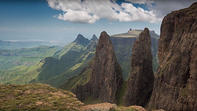The Holy Place
The mountain gods were angry. I stood in the mouth of a cave, watching the storm approach. The aquamarine afternoon light turned an eerie purple. The sun disappeared and soon the basalt spires were shrouded in grey. An air of menace filled the valley. Suddenly lightning split the gloom and thunderclaps echoed between sandstone ramparts, building to an almost continuous roar.

The very earth seemed to quake. Then came the rain in solid walls of water. It felt like a religious experience: the gods hurling their thunderbolts to test the disciple’s mettle. Indeed, these mountains have always been a holy place. All those who’ve come this way have worshipped them. Bushman shamans painted the rock with images of the spirit world, while the amaZizi (the local Bantu clan) sought spiritual sustenance in the mountains. The Zulu names for the peaks tell of their awe: Giant’s Castle, for example, is known as Bhulihawu – the shield thrasher. Voortrekker dominees looked to the Berg for examples of their God’s work, while British settlers were certainly thinking in religious terms when they named the crags.
There’s Cathedral Peak, the Bell, Organ Pipes, Twelve Apostles, Mitre, Monk’s Cowl and even the Devil’s Knuckles and a Devil’s Tooth. No sooner had it begun, than the storm passed and the valley was bathed in crystal light. The slopes tinkled with the sound of running water; the air was aromatic with the smell of drenched heathers and grasses.
Standing there, I thought of how today’s climbers and nature lovers also come to the Berg as a form of secular pilgrimage. Humbly dressed in hiking boots, shorts and T-shirts, the supplicants come to worship in the house of Nature at its most beguiling. Box Quote: The Lord said to Moses, ‘Come up to me on the mountain and stay here, and I will give you the tablets of stone, with the law and commands I have written for their instruction.’
By Justin Fox